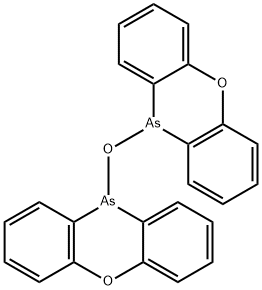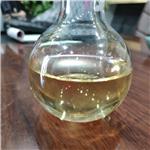0-100-Oxidiphenoxarsine is a colorless crystalline, organometallic solid or a dense yellow liquid. Molecularweight 5 502.23; Boiling point =233℃; Freezing/Meltingpoint =185℃. Decomposition temperature =380℃. Flashpoint =<32℃. Hazard Identification (based on NFPA-704M Rating System): Health 1, Flammability 0, Reactivity 1.Practically insoluble in water.
10-10′-Oxidiphenoxarsine is a colorless crystalline,
organometallic solid or a dense yellow liquid.
Odorless.
A clear light yellow liquid with a mild odor. Insoluble in water and slightly denser than water. Contact may severely irritate skin, eyes, and mucous membranes. Flash point 98°F.
Highly flammable. Insoluble in water.
Organometallics, such as 10,10-Oxybisphenoxarsine, are reactive with many other groups. Incompatible with acids and bases. Organometallics are good reducing agents and therefore incompatible with oxidizing agents.
(Non-Specific -- Arsenic Compounds) Arsenic compounds are acutely poisonous by ingestion. Ingestion or inhalation may result in chronic poisoning. Arsenic compounds are recognized carcinogens of the skin, lungs, and liver.
(Non-Specific -- Arsenic Compounds) When heated to decomposition, 10,10-Oxybisphenoxarsine emits highly toxic fumes of arsenic.
Poison by ingestion and inhalation. A severe skin irritant. When heated to decomposition it emits toxic fumes of As.
This material is used primarily for
fungicidal and bactericidal protection of plastics. It is an
organoarsenic and a heavy metal compound.
If this chemical gets into the eyes, remove anycontact lenses at once and irrigate immediately for at least15 min, occasionally lifting upper and lower lids. Seekmedical attention immediately. If this chemical contactsthe skin, remove contaminated clothing and wash immediately with soap and water. Seek medical attention immediately. If this chemical has been inhaled, remove fromexposure, begin rescue breathing (using universal precautions, including resuscitation mask) if breathing hasstopped and CPR if heart action has stopped. Transferpromptly to a medical facility. When this chemical hasbeen swallowed, get medical attention. Give large quantities of water and induce vomiting. Do not make an unconscious person vomit.Note to physician: For severe poisoning BAL [British AntiLewisite, Dimercaprol, dithiopropanol (C3H8OS2)] has beenused to treat toxic symptoms of certain heavy metalspoisoning—including arsenic. Although BAL is reported tohave a large margin of safety, caution must be exercisedbecause toxic effects maybe caused by excessive dosage.Most can be prevented by premedication with 1-ephedrinesulfate (CAS: 134-72-5). For milder poisoning penicillamine (not penicillin) has been used, both with mixed success. Side effects occur with such treatment and it is nevera substitute for controlling exposure. It can only be doneunder strict medical care.
(1) Color Code—Red: Flammability Hazard (dissolved in a flammablecarrier solvent): Store in a flammable liquid storage area or approved cabinet away fromignition sources and corrosive and reactive materials. (2)Color Code—Blue (carcinogen): Health Hazard/Poison:Store in a secure poison location. Prior to working with thischemical you should be trained on its proper handling andstorage. Store in tightly closed containers in a cool,well-ventilated area away from oxidizers. Where possible,automatically transfer material from drums or other storagecontainers to process containers. Sources of ignition, suchas smoking and open flames, are prohibited where thischemical is handled, used, or stored. Metal containersinvolving the transfer of this chemical should be groundedand bonded. Use only nonsparking tools and equipment,especially when opening and closing containers of thischemical. Wherever this chemical is used, handled, manufactured, or stored, use explosion-proof electrical equipmentand fittings. A regulated, marked area should be establishedwhere this chemical is handled, used, or stored in compliance with OSHA Standard 1910.1045.
UN1760 Corrosive liquids, n.o.s., Hazard class:
8; Labels: 8-Corrosive material, Technical Name Required.
UN3465 Organoarsenic compound, solid, n.o.s., Hazard
Class: 6.1; Labels: 6.1-Poisonous materials, Technical
Name Required.
A reducing agent; reacts violently with
strong oxidizers. Keep away from strong acids and strong
bases.
The ITSL for 10,10'-oxybisphenoxarsine oxide is 0.2 μg/m3 based on an annual averaging time.



